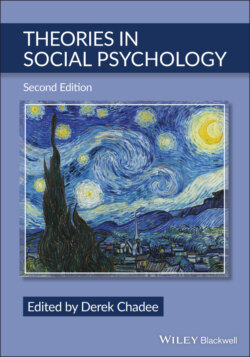Читать книгу Theories in Social Psychology - Группа авторов - Страница 28
Assumptions and Propositions of an Affect Arousal Reactance Theory (AART)
ОглавлениеThe following assumptions and propositions toward an Affect Arousal Reactance Theory (AART) build on and add to Professor Jack Brehm’s (1966) theory and offer another dimension to the understanding and development of psychological reactance.
Assumptions
1 There is a dynamic relationship between cognitive and affect processes.
2 Affect states and their concomitant arousal levels influence the intensity of reactions toward source(s) that threaten the removal of a free behavior.
3 Cognitive and affect processes, singularly or jointly, operate to accentuate or attenuate the intensity of reactance toward the source(s) that directly or indirectly threaten the removal of a free behavior.
Propositions
1 Negative affect associated with an approach motivation is more likely to increase psychological reactance than negative affect associated with avoidance motivation. The greater the perceived threat to a free behavior or the more valued a free behavior, the more intense the affect toward the source of the threat to the free behavior.
2 There is a direct relationship between the intensity of the affect arousal and the level of psychological reactance experienced. The higher the level of affect arousal the higher the magnitude of psychological reactance. Both the valence and intensity of affect state influence the degree of psychological reactance experienced.
3 Combination of state and trait reactance association with negative affect and approach motivation is more likely to increase the intensity of psychological reactance than the presence of only state or trait reactance.
4 The higher the affect arousal level associated with a threat to a free behavior, the greater the motivation to reduce the associated level of psychological reactance. Specifically, the higher the affect arousal level, and especially if it is a motivational approach arousal, associated with the threatened free behavior the greater the magnitude of psychological reactance and the greater the motivation for its reduction.
5 Among the reduction of psychological reactance strategies is the reduction of affect intensity/arousal. Reduction of affect arousal, ceteris paribus, will reduce the intensity of psychological reactance. High affect arousal could inhibit cognitive strategies which may otherwise have facilitated approaches in reduction of psychological reactance.
The first three propositions address the issue of intensity, and the last two propositions address the reduction of psychological reactance.
Figure 2.1 describes the process involved in the emergence of psychological reactance but considers the affect state. A threat to a free behavior is evaluated, provoking a negative affect state, the more important the threat, the greater the intensity of the affect state.
Figure 2.1 Affect arousal reactance model.
Cognitive appraisal, together with the concomitant affect, leads to approach motivation or an avoidance motivation. The cognitive evaluation with the affect state either accentuates or attenuate reactance. As evaluation is undertaken and, should the threat persist, reactance striving and/or reactance behavior continue. However, as discussed, reactance is moderated by a number of factors. The subjective experiences of emotions influence: the processing of information, decision-making processes, our attention, reaction time, and the way we intend to behave or actually behave (e.g., Clore et al., 2001; Derryberry & Tucker, 1994). Research undertaken by Kostic et al. (2011) has shown that the subjective experiences and intesity of emotions vary across cultures. For example, an unpleasant situation of uncertainty with threat toward the removal of a free behavior and the potential to create frustration and anger, emotion with the high intensity, has high reactance potential.
Threat to free behavior that provokes affect states associated with approach motivation will create a higher magnitude of reactance, ceteris paribus, than affect states associated with avoidance motivation. However, the magnitude of psychological reactance may vary across cultures, and this may not necessarily be a result of situational factors but a consequence of the subjective experience of emotions in these cultures. Clearly, research is needed to fully test an affect arousal reactance theory. In partial support of AART, Nesterkin (2013) in a conceptual paper postulates the relationship between negative affect states and reactance, energizing the latter and heightening the reaction toward the threat to a freedom. Clayton et al. (2019) emphasizing the emotion of anger only refer to the fight-flight energizing or demotivating effect on psychological reactance. The research agenda of Mühlberger et al. (2020) moves along a direction to understand the affect arousal relationship of reactance. These and other studies recognize the intermediate effect of affect states in energizing behavior toward the removal of freedom threats. However, there has been no attempt to systematically conceptualize this relationship within a theory that has been, over the years, argued as a cognitive social psychological theory.
